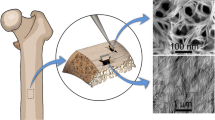Abstract
Purpose
Transmission electron microscopy (TEM) is widely used to study the ultrastructure of bone. The mineral of bone occurs as polycrystalline mineral plates about 3 to 6 nm in thickness. A problem in using TEM to make quantitative analyses of bone is that the orientation of the plates with respect to the plane of the section being imaged is expected to affect their apparent thickness. The purpose of this study was to test if this was true, if the apparent thickness of plates changed substantially as a result of tilt of the section.
Methods
We prepared TEM sections of samples of cortical human bone by ion beam milling, orienting one section parallel to the collagen fibril axes and one perpendicular to them. We obtained TEM bright field and HAADF images of these sections, tilting the sections up to ± 20° at 2° intervals and measuring the apparent thickness of individual mineral platelets at each angle of tilt.
Results
Thickness appears to double as section is tilted ± 20°. True thickness of plates is determined by tilting the section along an axis parallel to the plate orientation and determining the minimum apparent thickness. However, as plates are tilted away from minimum-thickness orientation, they become less well-resolved, disappearing when tilted more than 20°. We therefore also measured apparent thickness of only the darkest (most electron scattering) plate images in an untilted section and obtained the same average thickness as that obtained by tilting.
Conclusion
We conclude that tilting of the section is not necessary to obtain an accurate measurement of the thickness of mineral plates.







Similar content being viewed by others
References
Jantou V, Turmaine M, West GD, Horton MA, McComb DW (2009) Focused ion beam milling and ultramicrotomy of mineralised ivory dentine for analytical transmission electron microscopy. Micron 40:495–501. https://doi.org/10.1016/j.micron.2008.12.002
McNally EA, Schwarcz HP, Botton GA, Arsenault AL (2012) A model for the ultrastructure of bone based on electron microscopy of ion-milled sections. PLoS ONE 7:1–12. https://doi.org/10.1371/journal.pone.0029258
Nalla RK, Porter AE, Daraio C, Minor A, Radmilovic V, Stach E, Tomsia A, Ritchie R (2005) Ultrastructural examination of dentin using focused ion-beam cross-sectioning and transmission electron microscopy. Micron 36:672–680
Reznikov N, Bilton M, Lari L, Stevens MM, Kröger R (2018) Fractal-like hierarchical organization of bone begins at the nanoscale. Science. https://doi.org/10.1126/science.aao2189
Grandfield K, Vuong V, Schwarcz HP (2018) Ultrastructure of bone: hierarchical features from nanometer to micrometer scale revealed in focused ion beam sections in the TEM. Calcif Tissue Int 103:606–616. https://doi.org/10.1007/s00223-018-0454-9
Turunen MJ, Kaspersen JD, Olsson U, Guizar-Sicairos M, Bech M, Schaff F, Tägil M, Jurvelin JS, Isaksson H (2016) Bone mineral crystal size and organization vary across mature rat bone cortex. J Struct Biol. https://doi.org/10.1016/j.jsb.2016.07.005
Schwarcz HP, Binkley DM, Luo L, Grandfield K (2020) A search for apatite crystals in the gap zone of collagen fibrils in bone using dark-field illumination. Bone. https://doi.org/10.1016/j.bone.2020.115304
Schwarcz HP, McNally EA, Botton GA (2014) Dark-field transmission electron microscopy of cortical bone reveals details of extrafibrillar crystals. J Struct Biol 188:240–248. https://doi.org/10.1016/j.jsb.2014.10.005
Tong W, Glimcher MJ, Katz JL, Kuhn L, Eppell SJ (2003) Size and shape of mineralites in young bovine bone measured by atomic force microscopy. Calcif Tissue Int. https://doi.org/10.1007/s00223-002-1077-7
Fratzl P, Gupta HS, Paris O, Valenta A, Roschger P, Klaushofer K (2005) Diffracting “stacks of cards”—some thoughts about small-angle scattering from bone. Prog Colloid Polym Sci 130:33–39. https://doi.org/10.1007/b107343
Roschger P, Rinnerthaler S, Yates J, Rodan GA, Fratzl P, Klaushofer K (2001) Alendronate increases degree and uniformity of mineralization in cancellous bone and decreases the porosity in cortical bone of osteoporotic women. Bone. https://doi.org/10.1016/S8756-3282(01)00485-9
Vordos N, Drosos G, Kazanidis I, Ververidis A, Ypsilantis P, Kazakos K, Simopoulos C, Mitropoulos AC, Touloupidis S (2018) Hydroxyapatite crystal thickness and buckling phenomenon in bone nanostructure during mechanical tests. Ann Biomed Eng 46:627–639. https://doi.org/10.1007/s10439-018-1983-0
Acknowledgements
We are grateful to Ivan Strakhov and an unknown referee of a previous paper for having suggested the problem illustrated in Fig. 2 of this paper.
Funding
This research did not receive any specific grant from funding agencies in the public, commercial, or not-for-profit sectors.
Author information
Authors and Affiliations
Corresponding author
Ethics declarations
Conflict of interest
All authors have no conflict of interest.
Additional information
Publisher's Note
Springer Nature remains neutral with regard to jurisdictional claims in published maps and institutional affiliations.
About this article
Cite this article
Schwarcz, H., Micheletti, C. & Grandfield, K. Effect of plate orientation on apparent thickness of mineral plates by transmission electron microscopy. J Bone Miner Metab 42, 344–351 (2024). https://doi.org/10.1007/s00774-024-01507-5
Received:
Accepted:
Published:
Issue Date:
DOI: https://doi.org/10.1007/s00774-024-01507-5




